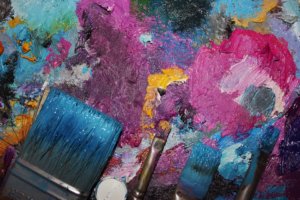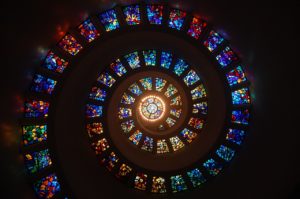To treat Art lighting as art in and of itself requires first an understanding of the scientific and aesthetic qualities of light. Light is a universal constant, because the speed of light is the fastest velocity in physical reality, and it can neither be altered nor exceeded. Light always travels in a straight line, and any obstruction in its path casts a shadow. Light always reflects to some degree off of any surface, which is what makes it possible for us to see any work of art. Light also can fill a space without consuming it, making it possible to use any form of lighting as art provided the angle of incident is aimed correctly at the piece. Improper angles will not only create shadows resulting from light spillage, but they will create glare as the beam reflects off the surface of the work back toward the viewer’s eyes.
Because light possesses many qualities that are absolute and inviolate, it is in one sense impossible to completely eliminate glare and shadow, because no matter what you do, some light is going to reflect off the piece, and sooner or later, the light will encounter some sort of obstruction that casts a shadow. A skillful art lighting company who specializes in designing light as art understands this, and rather than engage in the futile attempt to eliminate glare and shadow in defiance of the laws of physics, works instead in harmony with Nature’s laws and seeks to position any resulting glare and shadow outside of the viewer’s line of sight.
The old clich “Out of sight, out of mind,” rings very true when approaching artwork lighting as an art form unique unto itself.
To accomplish this, it is necessary to understand angles from a three-dimensional, as opposed to a two-dimensional, point of view. Light striking the surface of any art, including modern contemporary art from a nearby fixture constitutes one angle of incident. The reflected light coming back to the observer constitutes a second. The two must be measured carefully in relation to one another if one is to determine the appropriate position of any lighting fixture. If the right balance is struck, then reflective glare and resulting shadow will be hidden from his or her line of sight, allowing for an uninhibited experience of light and art from that particular viewing angle.
This calls for the art lighting designer to take a number of factors into account when installing an picture or art lighting system. First, the designer has to pinpoint all points of observation within a room where viewers will possibly be standing when they view various works. These points vary greatly based upon the environment and the type of room involved. Vantage points in museums are vastly different from those in office foyers and private living rooms. Secondly, the designer has to look at the surface of the art itself to assess its reflective qualities. High-end photography and certain forms of paint cause the surface of the image to have a *sheen* that acts as a virtual mirror, casting not only reflected color back into the eyes, but portions of the light beam itself. Dimmable, recessed art lighting is often required for such artwork in order to disperse illumination sufficiently not to shine back into the eyes.
Finally, one very important element to art lighting as art that many fail to even consider is the size and type of frame housing the piece in residential art designs. Light from a fixture that is placed too high will actually be blocked by the upper lip of the frame and cast what is called a *frame shadow* over the work. Something as simple as adjusting the level of the painting can often remedy this problem, although in formal galleries this may not be an option, and special fixtures with complex reflectors and filters may be needed to create a more indirect *wash* of luminance that results in both painting and frame being bathed in a radiant field of light as opposed to a bright beam of focused, direct light.
Perhaps one of the best tools available to art lighting consultants is a high-end art projector that allows for a variety of lighting level adjustments, advanced lighting filters and special reflectors, and the ability to proportionately size a beam to the precise dimensions of a work. While this does not completely eliminate glare and shadow (which the laws of physics mandate are inevitable with any form of lighting), it does give the collector or curator more power to control these negative elements, or in some cases, even turn them into art lighting attributes.
For example, many painters such as Goya, and certain genres such as surrealism, rely upon shadows to emphasize themes connected to the dark side of man, or the apparent duality of Nature itself. Placing too much light on such artwork will diminish its statement by overriding elements of shadow that the artist intended to be present. Phantom art lighting projectors can be dimmed and adjusted for such works so as to create a *lighted from within* effect that preserves the artist’s use of dark elements and negative images, providing just enough visibility for the viewer to see the work and its key aesthetic elements.
In a philosophical sense, we might say then that even darkness comes from light, and reality is more of a variation in luminance instead of a contrast between light and absence of light. Art challenges our thinking in much the same manner, forcing us to confront a world of color, light, and shadow that coalesce together in often-ambiguous patterns that force us to question our view of the world and explore the unknown through the eyes of the artist. The same hold true when designing and installing and designing landscape lighting.
To light art, you must understand both light and art, and art as light from the vantage point of a trained consultant. While becoming a consultant may take years of training and practice, with the help of a qualified electrical contractor, you can achieve the same results through partnership and dialogue with an expert.
Submitted by:Candice ChristieCandice Christie is a well respected art expert employed by modern art reproduction specialists http://www.GalerieDada.com |





